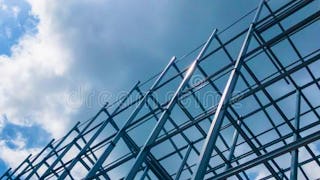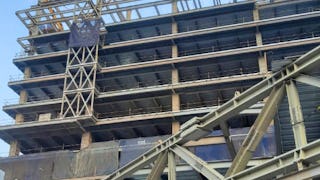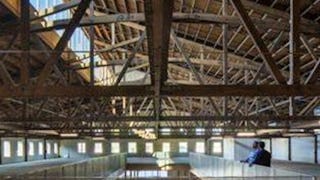"Design Basics of Steel Buildings" is a comprehensive course that covers all fundamental aspects of designing steel structures. Participants delve into the foundational elements essential for successful building design, including understanding the basis for design through comprehensive reports and considering site location in conjunction with building functionality. Geometric parameters of the building are explored to ensure structural integrity and aesthetic appeal.


Design Basics of Steel Buildings
This course is part of Steel Multi Storey Building - System Design Specialization

Instructor: Subject Matter Expert
2,864 already enrolled
Included with
(18 reviews)
Recommended experience
What you'll learn
Recall foundational principles of steel building design, including basis for design reports, site location considerations, and geometric parameters.
Understand how site location impacts building function & consider exposure conditions and corrosion protection for steel structures.
"Utilize material knowledge, design loads, and calculation methods to solve steel building design problems, including wind and earthquake loads."
Skills you'll gain
Details to know

Add to your LinkedIn profile
6 assignments
See how employees at top companies are mastering in-demand skills

Build your subject-matter expertise
- Learn new concepts from industry experts
- Gain a foundational understanding of a subject or tool
- Develop job-relevant skills with hands-on projects
- Earn a shareable career certificate

There are 6 modules in this course
This module covers the fundamental aspects of designing and constructing steel buildings, including the aspects covered in a design basis report, site location considerations, geometric parameters, structural systems, special geometries, and materials such as structural steel, concrete, reinforcement, bolts, welds, fireproofing & paints, to achieve a specified design life of the structure.
What's included
12 videos1 assignment
This module covers the design loads, considerations for gravity and lateral loads, load combinations based on codes, serviceability requirements, deflection limits, floor vibration, fire resistance, integration of services with the structure, and a practical example of a Structural Design Basis Report (DBR)
What's included
9 videos1 assignment
This module covers the calculation of various vertical loads, starting with dead loads, including the self-weight calculation of foundation, beam, column, truss & floor systems, superimposed dead loads from various building elements & functionalities. It also addresses live loads, considering different occupancies, and some special load cases. Preparations of load layouts, and the impact of temperature on structural loads in the design and construction of steel buildings are also included in this module.
What's included
12 videos1 assignment
This module focuses on lateral loads in buildings, covering wind loads & its calculation methods for a sample building. It also includes discussions on drag, interference, and dynamic effects in structures. Additionally, earthquake loads acting on a building are addressed, incorporating zone factors, response reduction factors, and base shear calculation based on the equivalent static method.
What's included
14 videos1 assignment
This module covers structural layout planning for vertical load resisting systems, with an example grid planning for car parkings and other buildings. It discusses the vertical load resisting system, including slabs, beams & deck sheets. Additionally, it covers the use of chequered plates, grating, deep deck, hollow core, and RC slabs as floor systems in steel buildings. The module also addresses beams and trusses, covering beam orientation, preliminary sizing, load calculations, column placement, live load reduction, and the importance of service coordination in buildings.
What's included
16 videos1 assignment
This module explores lateral load resisting systems in buildings, detailing code guidelines and showcasing their significance. It delves into moment resisting frames, braced frames, shear walls, and use of lateral load resisting systems in very tall buildings. The content covers lateral load flow in braced frame systems, planning considerations, and preliminary sizing of lateral load resisting systems for effective structural design.
What's included
11 videos1 assignment
Earn a career certificate
Add this credential to your LinkedIn profile, resume, or CV. Share it on social media and in your performance review.
Instructor

Offered by
Explore more from Environmental Science and Sustainability
 Status: Free Trial
Status: Free Trial Status: Free Trial
Status: Free TrialL&T EduTech
 Status: Free Trial
Status: Free TrialL&T EduTech
 Status: Free Trial
Status: Free TrialL&T EduTech
Why people choose Coursera for their career




Learner reviews
18 reviews
- 5 stars
88.88%
- 4 stars
5.55%
- 3 stars
5.55%
- 2 stars
0%
- 1 star
0%
Showing 3 of 18
Reviewed on Jan 22, 2025
Actually this course was much beyond my expectation in terms of content, presentation, inclusivity and much more

Open new doors with Coursera Plus
Unlimited access to 10,000+ world-class courses, hands-on projects, and job-ready certificate programs - all included in your subscription
Advance your career with an online degree
Earn a degree from world-class universities - 100% online
Join over 3,400 global companies that choose Coursera for Business
Upskill your employees to excel in the digital economy
Frequently asked questions
To access the course materials, assignments and to earn a Certificate, you will need to purchase the Certificate experience when you enroll in a course. You can try a Free Trial instead, or apply for Financial Aid. The course may offer 'Full Course, No Certificate' instead. This option lets you see all course materials, submit required assessments, and get a final grade. This also means that you will not be able to purchase a Certificate experience.
When you enroll in the course, you get access to all of the courses in the Specialization, and you earn a certificate when you complete the work. Your electronic Certificate will be added to your Accomplishments page - from there, you can print your Certificate or add it to your LinkedIn profile.
Yes. In select learning programs, you can apply for financial aid or a scholarship if you can’t afford the enrollment fee. If fin aid or scholarship is available for your learning program selection, you’ll find a link to apply on the description page.
More questions
Financial aid available,

